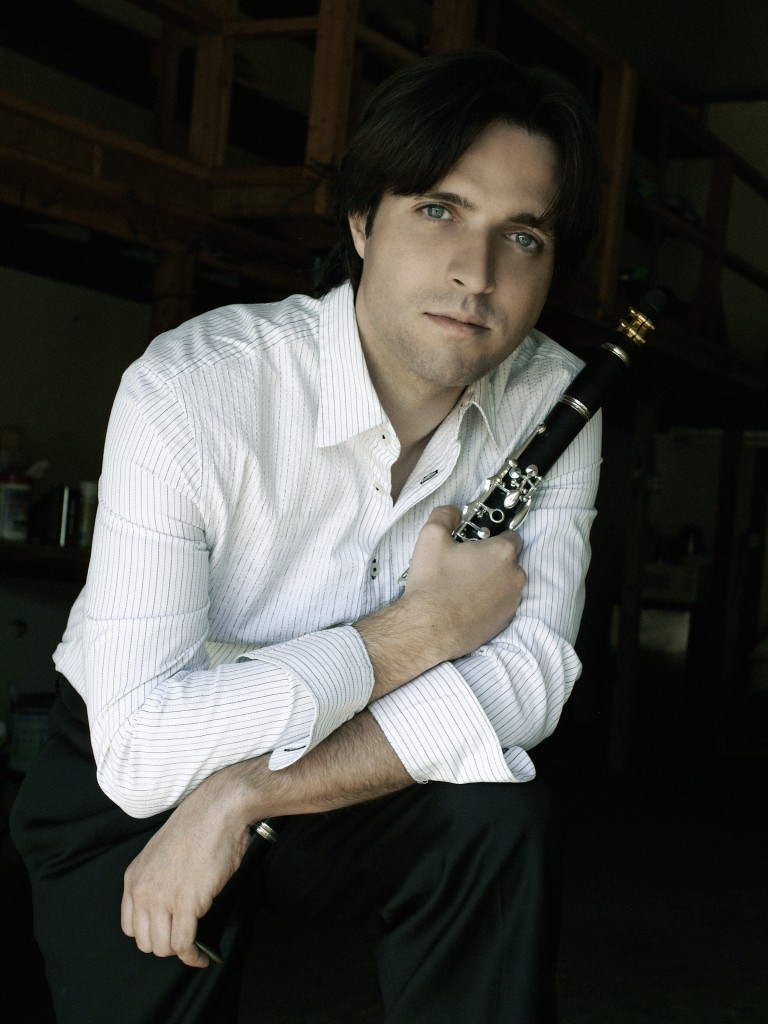Jose Franch-Ballester, clarinet. Photo-Louisville Orchestra.
Louisville Orchestra: Dvořák “New World”
Rossen Milanov, conductor
Jose Franch-Ballester, clarinet
Review by Shaun Kenney
Entire contents are copyright © 2014 Shaun Kenney. All rights reserved.
To me, there is nothing more magical in the world of music than a live, orchestral performance. The way the individual string sections all move their bows as one, how the horns hold their bells high during prominent passages, and the conductor’s sometimes graceful, sometimes erratic movements all add a visual facet to an art that is usually only experienced through the ears. Last night’s performance by the Louisville Orchestra and conductor Rossen Milanov was no exception.
The evening started off with two musical suites derived from the ballet The Three-Cornered Hat by Manuel de Falla. Pulling extensively from the folk music and dance styles of Andalusia, a section of southern Spain across the Mediterranean Sea from Morocco, the ballet tells the story of a miller, his wife, and a lusty magistrate. The first suite, although played without any pauses, is divided into five sections and begins dramatically with a timpani beat followed by a trumpet fanfare announcing the magistrate’s arrival. It moves quickly into a string and woodwind section that clearly sets us in Spain. The third section, which is highlighted with woodwind trills and swelling strings, depicts the miller’s wife dancing a fandango while being watched by the magistrate, who is represented (as a large man in my imagination) by a heavy, yet bouncy bassoon solo. The last section of this suite is meant to show the miller’s wife enticing the magistrate with a bunch of grapes. It circles back with echoes of the fandango, punctuated by muted trumpet staccato notes and a smooth oboe passage, wrapping up with an abrupt final glissando.
The second suite is in three sections outlining Act II of the ballet and begins with the villagers participating in an Andalusian folk dance called the seguidilla. This section is accented with short flute, oboe, and clarinet solos along with pizzicato strings and muted brass. After a slight pause we hear a majestic horn solo introducing the miller, who dances a farruca (a form of flamenco traditionally danced by only men) for his guests. An English horn solo follows as we are swept up into this slow dramatic dance. The suite concludes with a final dance between the miller and his wife. The urgency and varying tempos of this section clearly show the passion of this dance.
The first half of the evening ended with Oscar Navarro’s Il Concerto for Clarinet and Orchestra performed by Jose Franch-Ballester. Before I begin, I have a confession to make. I don’t like the clarinet. It is probably my least favorite instrument to listen to. Perhaps this is because the majority of my experience with the woodwind comes from student teaching in a sixth grade band class where, even on a good day, most students can only elicit a sound reminiscent of a dying duck. This night I was most pleasantly surprised by this concerto. In fact, it may have converted me from clarinet hater to clarinet lover. The work opens with soft vibraphone notes over a quiet string drone. Mr. Franch-Ballester began to play, and I was hooked from his first note. It is a low, haunting melody that ends with a breath of air pushed through the clarinet reminding me of a breeze rustling through tall grasses. I am getting goose bumps just thinking of the beautiful, deep tone Mr. Franch-Ballester produced during this section. I was on the edge of my seat for the remainder of the performance. Though the rich orchestral accompaniment does not overpower the soloist at any point, there are dramatic and sweeping sections where the soloist is tacet and the orchestra shines on its own. At one point during the first movement the soloist is accompanied by some very interesting percussion, including hand claps from the brass and woodwind sections. The second movement begins without pause and is much slower and ethereal, ending with an orchestral choral reminiscent of an epic film score. The brisk third movement allows the soloist to show off his virtuosic techniques with impressive runs and a wide display of range. This concerto ended up being my favorite work of the evening. I would highly recommend that everyone listen to this piece at some point. I was lucky enough to find a recording of the premier performance online and was pleased to see that it featured both Mr. Franch-Ballester and conductor Rossen Milanov.
After the intermission we settled in for a performance of Antonín Dvořák’s Symphony No. 9 in E Minor, “From the New World.” It is often considered to be Dvořák’s most popular piece and one that I think a lot of people are familiar with whether you’re a fan of orchestral music or not. This specific performance was as good as any that I have heard, and I was particularly impressed with Mr. Milanov’s decision to conduct the symphony without a score in front of him. It was clear that he was extremely comfortable with every nuance of the work, and I very much enjoyed watching him in his element.
Dvořák “New World”
January 11, 2014
Louisville Orchestra
Brown Theatre
315 W. Broadway
Louisville, KY 40202



